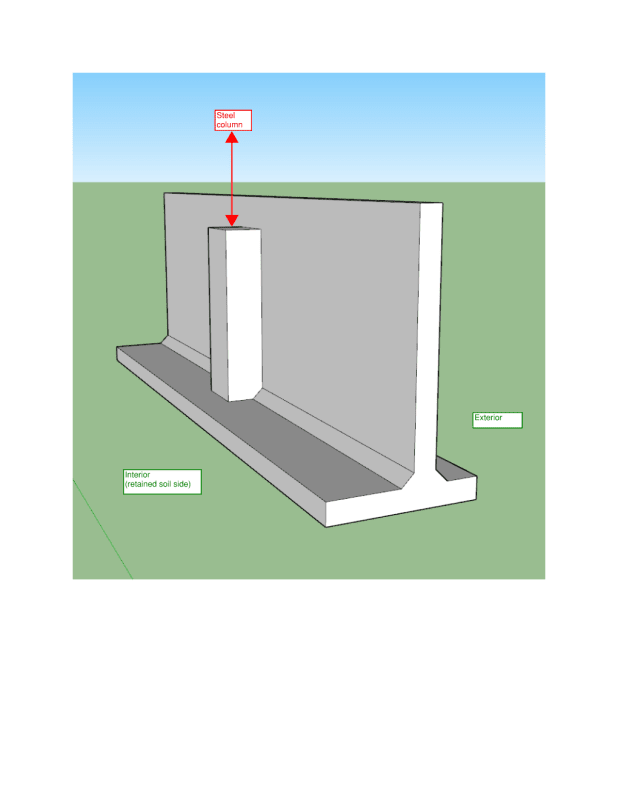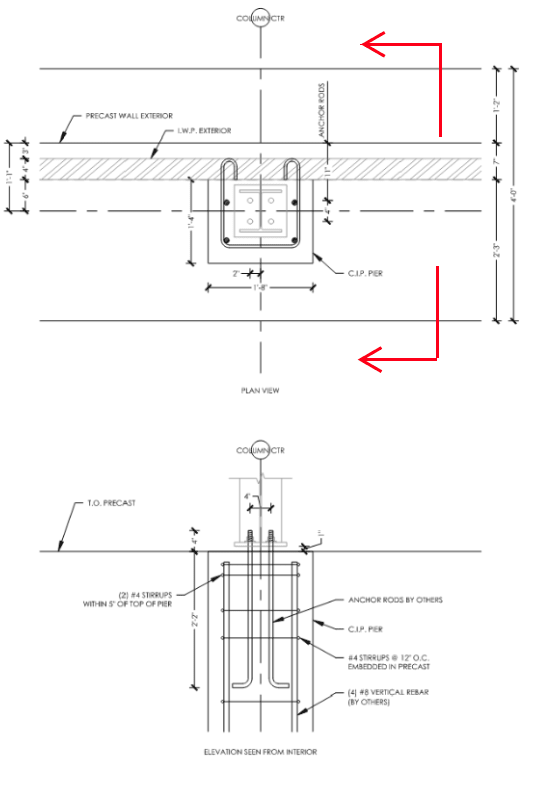Lingwist
Structural
- Oct 22, 2020
- 6
Hi all, first time posting here so please excuse any faux pas, but I wanted to start with a thank you to the community. I have learned a lot perusing this forum over the last few years.
I wanted to get opinions on a situation where a cantilever retaining wall is also being used as a column footing. I have seen this design used on projects by an engineer who has since retired, and now a customer wants to use the same design, so I want to make sure I understand how to justify it. I've added a photo below, and attached a couple details to clarify (Detail 1 and Detail 2), but basically the cantilever retaining wall is precast, and the column pier is cast in place after the precast piece is set in the field. The only reinforcing actually connecting the two are a set of stirrups which project from the wall into the pier.
The wall works fairly well as a retaining wall, and the downward loads on the building columns seem to transfer to the wall heel in an obvious way. What I'm less sure about is the uplift, which can be up to 25 kips or so. There are vertical rebars in the pier, but they don't connect to the wall heel, and even if they did, they don't seem to have much room to develop anything. So that leaves the stirrups to get the uplift into the wall. Please correct my thinking here: the uplift is transferred to the cast in place pier by the anchor rods being developed or lapped with the vertical pier rebar, and then...? Does the force go from pier to wall via shear friction at the stirrups? Does this seem reasonable?
I also noted that ACI 318 has some requirements that could affect this in 16.3, and in particular 16.3.4 and 16.3.5. I'm not sure if these provisions could be satisfied by the stirrups, since I guess technically they cross the interface between the pier and the cantilever wall.
Any comments would be much appreciated! Thanks.

I wanted to get opinions on a situation where a cantilever retaining wall is also being used as a column footing. I have seen this design used on projects by an engineer who has since retired, and now a customer wants to use the same design, so I want to make sure I understand how to justify it. I've added a photo below, and attached a couple details to clarify (Detail 1 and Detail 2), but basically the cantilever retaining wall is precast, and the column pier is cast in place after the precast piece is set in the field. The only reinforcing actually connecting the two are a set of stirrups which project from the wall into the pier.
The wall works fairly well as a retaining wall, and the downward loads on the building columns seem to transfer to the wall heel in an obvious way. What I'm less sure about is the uplift, which can be up to 25 kips or so. There are vertical rebars in the pier, but they don't connect to the wall heel, and even if they did, they don't seem to have much room to develop anything. So that leaves the stirrups to get the uplift into the wall. Please correct my thinking here: the uplift is transferred to the cast in place pier by the anchor rods being developed or lapped with the vertical pier rebar, and then...? Does the force go from pier to wall via shear friction at the stirrups? Does this seem reasonable?
I also noted that ACI 318 has some requirements that could affect this in 16.3, and in particular 16.3.4 and 16.3.5. I'm not sure if these provisions could be satisfied by the stirrups, since I guess technically they cross the interface between the pier and the cantilever wall.
Any comments would be much appreciated! Thanks.




